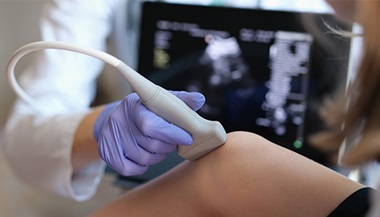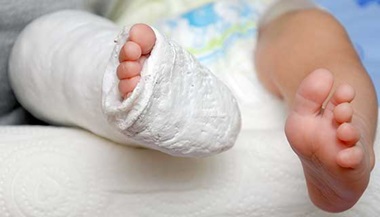Chest Wall Malformations
What is pectus excavatum?
Pectus excavatum (PE), translated literally as “hollowed chest” and also referred to as "sunken chest" or "funnel chest," is the most common chest wall deformity seen in children. An overgrowth of the rib cartilages before and after birth causes the characteristic depression of the sternum (breastbone). The cause of PE is not known, but often the tendency to develop PE runs in families. Depending on the seriousness of the defect, PE may cause poor posture with slumped shoulders and a protruding abdomen or "pot belly," as well as possible problems with bone growth and alignment later in life. In severe cases, PE shifts the heart to the left side of the chest and compresses the lungs, limiting the child's ability to take deep breaths. This defect commonly worsens during puberty until age 18 when most of the growth spurt is complete.
Symptoms
Children with PE usually have no symptoms, but the defect becomes more pronounced with the growth of the chest during puberty. Some teenagers with PE complain of shortness of breath with exertion and pain at the front of the chest and may say that they tire easily.
Diagnosis
The defect is measured using thoracic depth measurements (TDM) to compare the right to left side of the defect using a line created from the nipple to the vertebral column. Differences of less than 1 cm are considered a mild deformity. TDM defects between 1 cm and 2.5 cm are moderate, and a greater than 2.5 cm defect is considered a severe deformity. Surgical repair is recommended in children with defects that are moderate to severe. Other methods of measurement employ CT scanning to calculate the Haller index — this number compares the depth of the chest cavity beneath the sternum to the width of the chest cavity (from right to left). The normal ratio of width-to-depth is about 2.5 to 1.
Treatment
Safe repair of PE is best performed in children over five years of age. The preferred age for repair is at about 14 years of age. The operation is easier and the recovery is shorter in this age group because in most cases, the majority of the pubertal growth spurt has passed, but the rib bones are still incompletely formed (ossified). This allows the chest wall to reform into a more normal shape as the child grows after the repair. Older adolescents and adults also report good results with repair. The operation to repair PE is called a Nuss procedure and involves the placement of one or more stabilizing metal bars just inside the ribcage to move the sternum forward. The bars are shaped to the patient during the operation and remain in place for several years to allow the ribs to adjust to the new shape of the chest. The bars are then removed in a separate operation.
Recovery
Improvement in the chest wall varies and depends on the severity of the defect. A common problem from this procedure is a pneumothorax (air within the chest cavity but outside the lungs). Your child will have an X-ray the morning after surgery to identify any problems.





